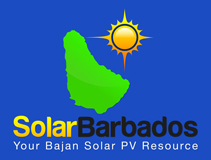As much as solar energy is about saving the planet, helping the environment and creating a more sustainable society for future generations, the increasingly popular driving force is money. A solar PV system has to make economic sense before a homeowner or business owner makes a purchase. What better way to learn about the financial opportunity than an actual case study from an operating solar PV system in Barbados? Let’s dive into the numbers.

System summary
System size: 5.1kW DC (5kW AC)
Solar panels: 20 x 255W Trina
Inverter: 1 x SMA Sunny Boy 5000a
Annual energy generated: 6305kWh
Annual RE credits from BL&P: $4643.43
In operation since: September 2013
This system has been operating for over a year which has provided a good sample size of data. Rather than tell you the numbers and have you take my word for it, here is the proof: below is the actual bill (I should actually say statement) from BL&P from September 2014.
A few sections have been highlighted:
1) Monthly usage and daily usage
The monthly totals of energy (kWh) that are consumed and produced on site are logged here. “Present” is used to indicate the amount which is consumed. For the month of September 2014 it was 363kWh. “Present Purch.” is the term used to indicate the amount of energy which is generated. It literally is the present amount of electricity that BL&P is purchasing from you! For September 2014 the amount of energy generated and purchased (by the utility) was 515kWh. As you can easily see, the generation is greater than the consumption which means nothing is owed to BL&P, in fact credit is being accrued so they owe the RE producer. It is no longer a utility bill but rather a statement. The other related number is the Daily Avg. (kWh). This shows approximately how much energy is consumed on a daily basis and how much is produced on a daily basis.
2) Energy graph for the previous year
It’s a beautiful sight isn’t it? Every month for the last year (since it was turned on), the system has consistently generated more electricity than the house consumed. Here you can see the 363kWh and 515kWh that were discussed in the first point. Since the production is directly tied to the amount of sunshine you can draw meteorological conclusions from the data such as December 2013 and January 2014 being rainy/cloudy. November 2013 and May 2014 on the other hand were particularly sunny. One point to mention here is that at any point (before or after your system is installed) you can employ energy conservation and energy efficiency techniques to reduce your consumption. Switching to LED bulbs, being more conscientious about what lights are left on, and upgrading to more energy efficient appliances will reduce the amount of electricity consumed. By changing this side of the equation you increase the overall credit that accrues.
3) Renewable Energy Credit
This is where the RE credit is calculated, 1.6 x FCA (fuel clause adjustment). It is then summed with the sub total and VAT to arrive at the Current Charges, in this case a credit.
4) Total RE credits (since last cheque)
Saved the best for last, this is where you see the total renewable energy credits that have been accrued since the last cheque was sent. After eliminating the monthly electricity bill, this solar PV system has generated $1687.33 in RE credits. At the end of the year, BL&P will issue a cheque for the balance as it does not roll over each year. Here is the cheque notice from January 2014, followed by the cheque notice from December 2014, and the cheque from December 2014.



Bottom line:
Here are the RE credits that the system generated for each of the 12 months, before the consumption was subtracted. This is the revenue the system actually produced: $4643.43.
|
RE credit |
Year 1 |
| Oct-13 | $ 355.95 |
| Nov-13 | $ 519.80 |
| Dec-13 | $ 285.52 |
| Jan-14 | $ 254.66 |
| Feb-14 | $ 314.30 |
| Mar-14 | $ 390.47 |
| Apr-14 | $ 343.73 |
| May-14 | $ 513.72 |
| Jun-14 | $ 443.55 |
| Jul-14 | $ 439.30 |
| Aug-14 | $ 417.23 |
| Sep-14 | $ 365.20 |
| Total |
$ 4,643.43 |
The cost of the system was $39,100 then, which makes the ROI a respectable 11.88%. You’ve now seen the numbers, the bottom line is that it is possible to purchase a system that will not only eliminate your electricity bill, but also put money in your pocket.

